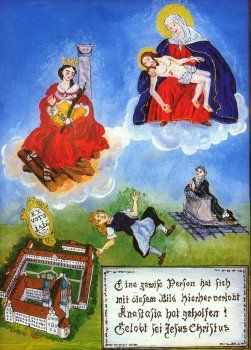|
Deutsches Epilepsiemuseum Kork  Deutsches Epilepsiemuseum Kork www.epilepsiemuseum.de |
The legends of two martyrs are combined in the figure of Saint Anastasia (Greek: the risen one): Anastasia of Sirmium (Croatia) and Anastasia, the Roman. Both are said to have died in the year 304. The church celebrates the Roman saint's day on December 25th. Anastasia's name was included in the canon of masses in the 3rd mass on Christmas Day, the Shepherd's Mass. People pray to the saint for help with illnesses of the chest, but especially with illnesses of the head (also epilepsy). Anastasia, the Roman, was the daughter of the imperial administrative official Praetextatus and his Christian wife Flavia. After her mother's early death, Anastasia was brought up by the Christian Chrysogomus. She was forced to marry the high-ranking but immoral heathen Publius against her will, but she was able to remain chaste. In spite of her husband's brutal objections, she took care of Christians in Roman prisons. After Publius' death, she escaped the pursuits of the Roman house owner and accompanied her Christian teacher Chrysogomus to Aquileia, where, together with 200 virgins, whom they had converted, she died a martyr's death. |



